Consumer Behavior Analysis: Bathing Soap Procurement Study
VerifiedAdded on 2023/06/07
|38
|3482
|162
Report
AI Summary
This report presents an exploratory study on consumer behavior analysis in the fast-moving consumer goods (FMCG) sector, specifically focusing on bathing soap procurement. The research utilizes a survey instrument developed on the Survey Monkey platform to collect primary data from 40 respondents, examining their preferences, attitudes, and motivations. The data analysis includes gender and age classifications, revealing insights into fragrance preferences, package size choices, and value perceptions. The study explores the influence of social media on purchasing decisions and investigates brand preferences, highlighting cultural and lifestyle factors. Key findings include the prominence of fragrance as a purchase attribute, the impact of social media advertisements, and the preference for larger soap bar sizes. The report concludes with a discussion of consumer motivations and the implications for FMCG marketing strategies, with the data analyzed using Excel and STATA. The study provides a valuable understanding of consumer behavior within the competitive bathing soap market.
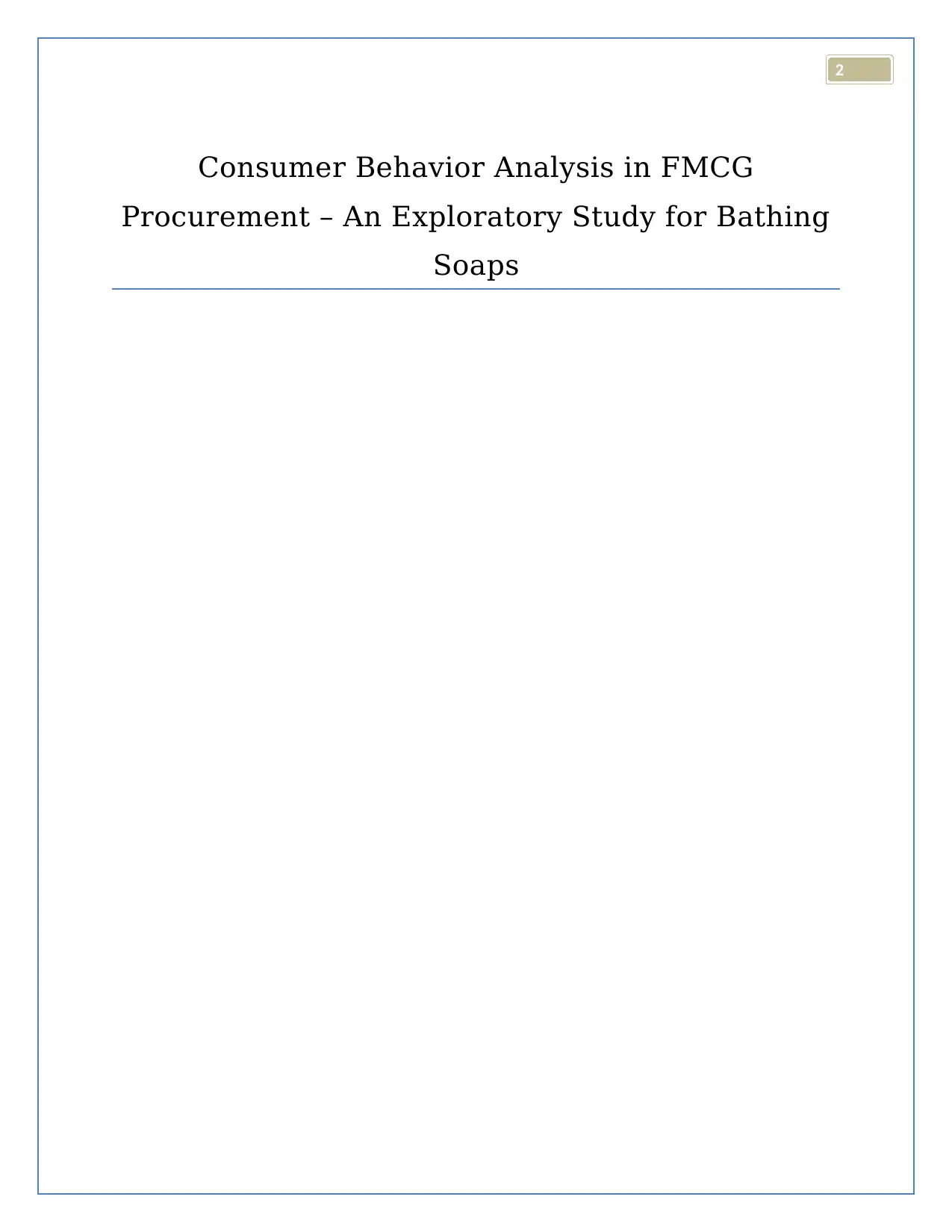
2
Consumer Behavior Analysis in FMCG
Procurement – An Exploratory Study for Bathing
Soaps
Consumer Behavior Analysis in FMCG
Procurement – An Exploratory Study for Bathing
Soaps
Paraphrase This Document
Need a fresh take? Get an instant paraphrase of this document with our AI Paraphraser
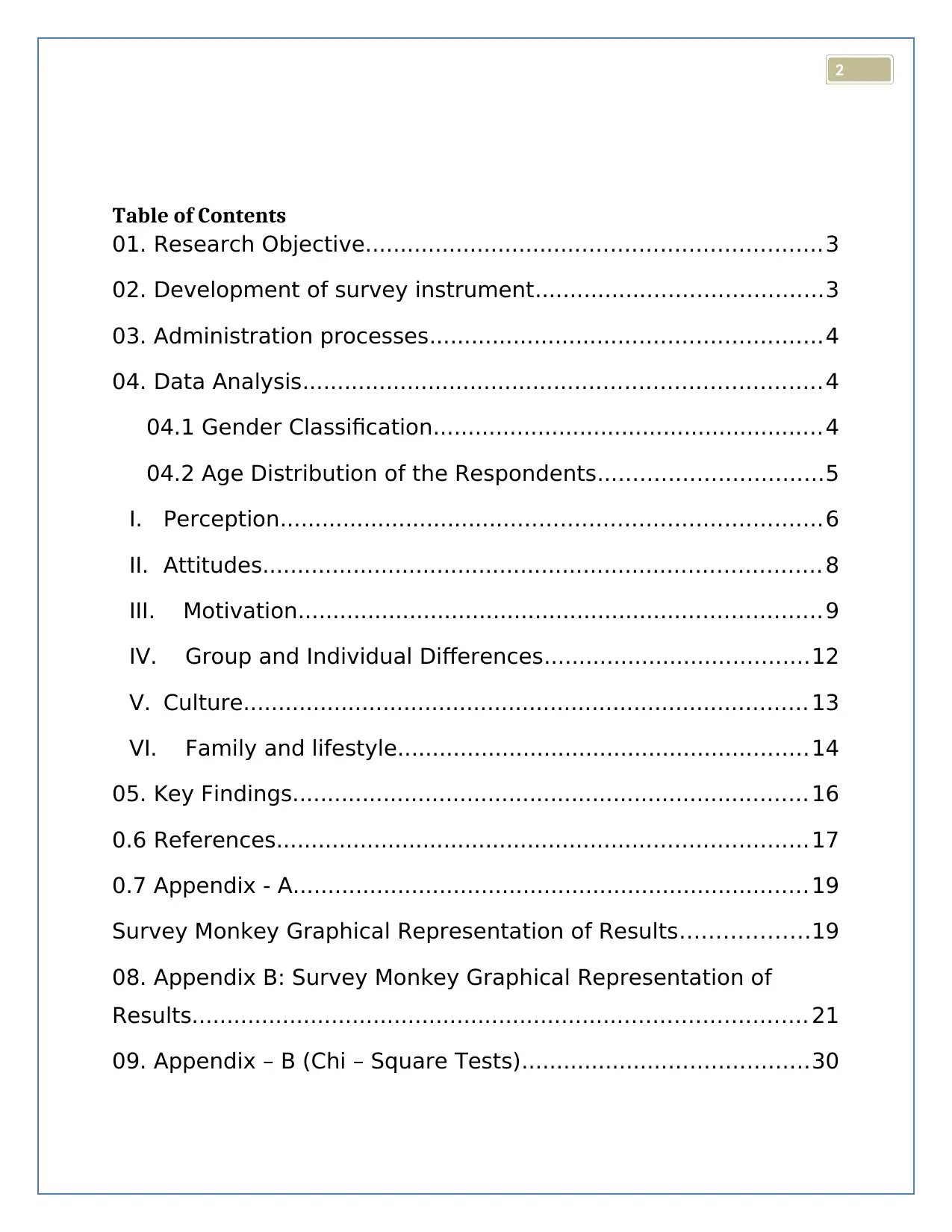
2
Table of Contents
01. Research Objective.................................................................3
02. Development of survey instrument.........................................3
03. Administration processes........................................................4
04. Data Analysis..........................................................................4
04.1 Gender Classification........................................................4
04.2 Age Distribution of the Respondents................................5
I. Perception.............................................................................6
II. Attitudes................................................................................ 8
III. Motivation...........................................................................9
IV. Group and Individual Differences......................................12
V. Culture................................................................................. 13
VI. Family and lifestyle...........................................................14
05. Key Findings.......................................................................... 16
0.6 References............................................................................17
0.7 Appendix - A.......................................................................... 19
Survey Monkey Graphical Representation of Results..................19
08. Appendix B: Survey Monkey Graphical Representation of
Results........................................................................................ 21
09. Appendix – B (Chi – Square Tests).........................................30
Table of Contents
01. Research Objective.................................................................3
02. Development of survey instrument.........................................3
03. Administration processes........................................................4
04. Data Analysis..........................................................................4
04.1 Gender Classification........................................................4
04.2 Age Distribution of the Respondents................................5
I. Perception.............................................................................6
II. Attitudes................................................................................ 8
III. Motivation...........................................................................9
IV. Group and Individual Differences......................................12
V. Culture................................................................................. 13
VI. Family and lifestyle...........................................................14
05. Key Findings.......................................................................... 16
0.6 References............................................................................17
0.7 Appendix - A.......................................................................... 19
Survey Monkey Graphical Representation of Results..................19
08. Appendix B: Survey Monkey Graphical Representation of
Results........................................................................................ 21
09. Appendix – B (Chi – Square Tests).........................................30
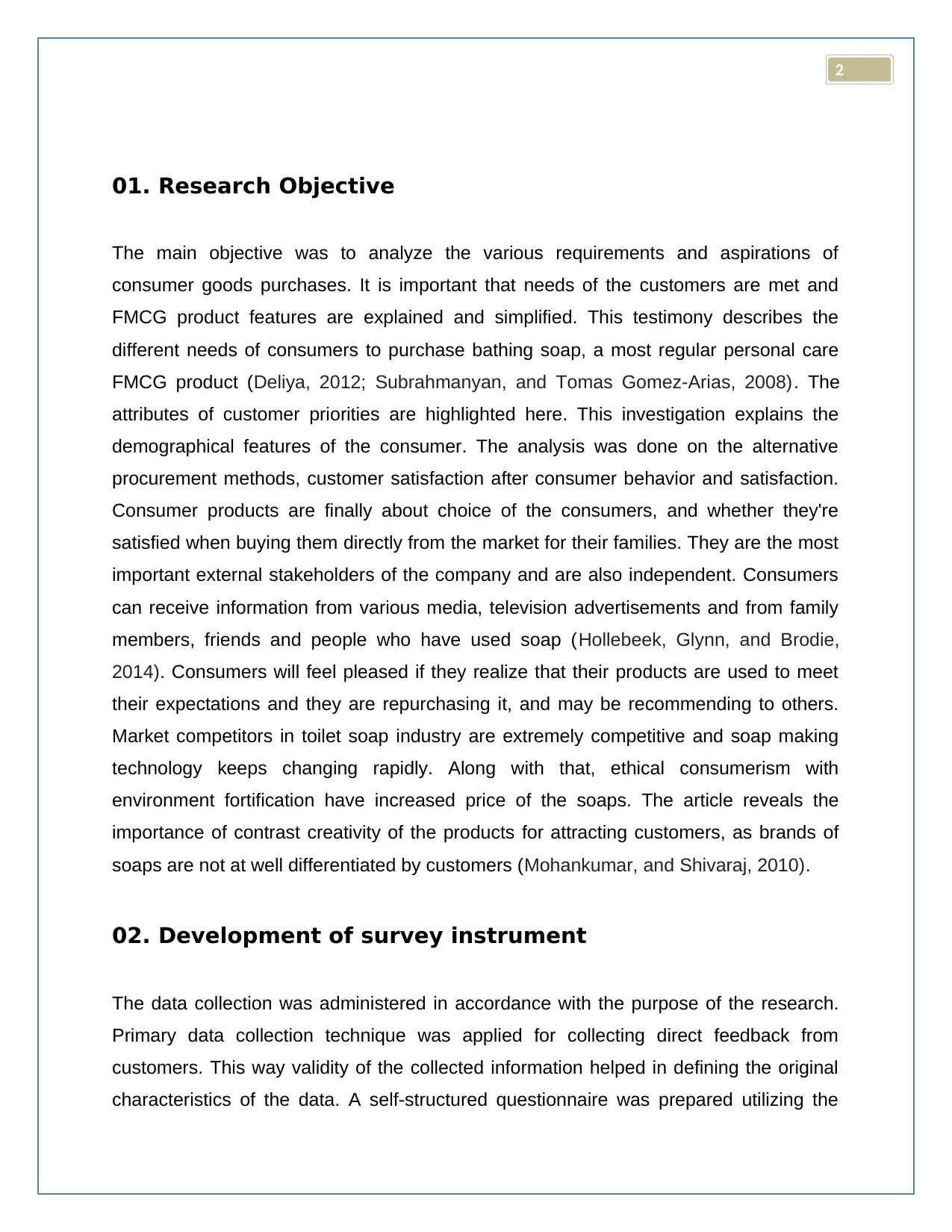
2
01. Research Objective
The main objective was to analyze the various requirements and aspirations of
consumer goods purchases. It is important that needs of the customers are met and
FMCG product features are explained and simplified. This testimony describes the
different needs of consumers to purchase bathing soap, a most regular personal care
FMCG product (Deliya, 2012; Subrahmanyan, and Tomas Gomez-Arias, 2008). The
attributes of customer priorities are highlighted here. This investigation explains the
demographical features of the consumer. The analysis was done on the alternative
procurement methods, customer satisfaction after consumer behavior and satisfaction.
Consumer products are finally about choice of the consumers, and whether they're
satisfied when buying them directly from the market for their families. They are the most
important external stakeholders of the company and are also independent. Consumers
can receive information from various media, television advertisements and from family
members, friends and people who have used soap (Hollebeek, Glynn, and Brodie,
2014). Consumers will feel pleased if they realize that their products are used to meet
their expectations and they are repurchasing it, and may be recommending to others.
Market competitors in toilet soap industry are extremely competitive and soap making
technology keeps changing rapidly. Along with that, ethical consumerism with
environment fortification have increased price of the soaps. The article reveals the
importance of contrast creativity of the products for attracting customers, as brands of
soaps are not at well differentiated by customers (Mohankumar, and Shivaraj, 2010).
02. Development of survey instrument
The data collection was administered in accordance with the purpose of the research.
Primary data collection technique was applied for collecting direct feedback from
customers. This way validity of the collected information helped in defining the original
characteristics of the data. A self-structured questionnaire was prepared utilizing the
01. Research Objective
The main objective was to analyze the various requirements and aspirations of
consumer goods purchases. It is important that needs of the customers are met and
FMCG product features are explained and simplified. This testimony describes the
different needs of consumers to purchase bathing soap, a most regular personal care
FMCG product (Deliya, 2012; Subrahmanyan, and Tomas Gomez-Arias, 2008). The
attributes of customer priorities are highlighted here. This investigation explains the
demographical features of the consumer. The analysis was done on the alternative
procurement methods, customer satisfaction after consumer behavior and satisfaction.
Consumer products are finally about choice of the consumers, and whether they're
satisfied when buying them directly from the market for their families. They are the most
important external stakeholders of the company and are also independent. Consumers
can receive information from various media, television advertisements and from family
members, friends and people who have used soap (Hollebeek, Glynn, and Brodie,
2014). Consumers will feel pleased if they realize that their products are used to meet
their expectations and they are repurchasing it, and may be recommending to others.
Market competitors in toilet soap industry are extremely competitive and soap making
technology keeps changing rapidly. Along with that, ethical consumerism with
environment fortification have increased price of the soaps. The article reveals the
importance of contrast creativity of the products for attracting customers, as brands of
soaps are not at well differentiated by customers (Mohankumar, and Shivaraj, 2010).
02. Development of survey instrument
The data collection was administered in accordance with the purpose of the research.
Primary data collection technique was applied for collecting direct feedback from
customers. This way validity of the collected information helped in defining the original
characteristics of the data. A self-structured questionnaire was prepared utilizing the
⊘ This is a preview!⊘
Do you want full access?
Subscribe today to unlock all pages.

Trusted by 1+ million students worldwide
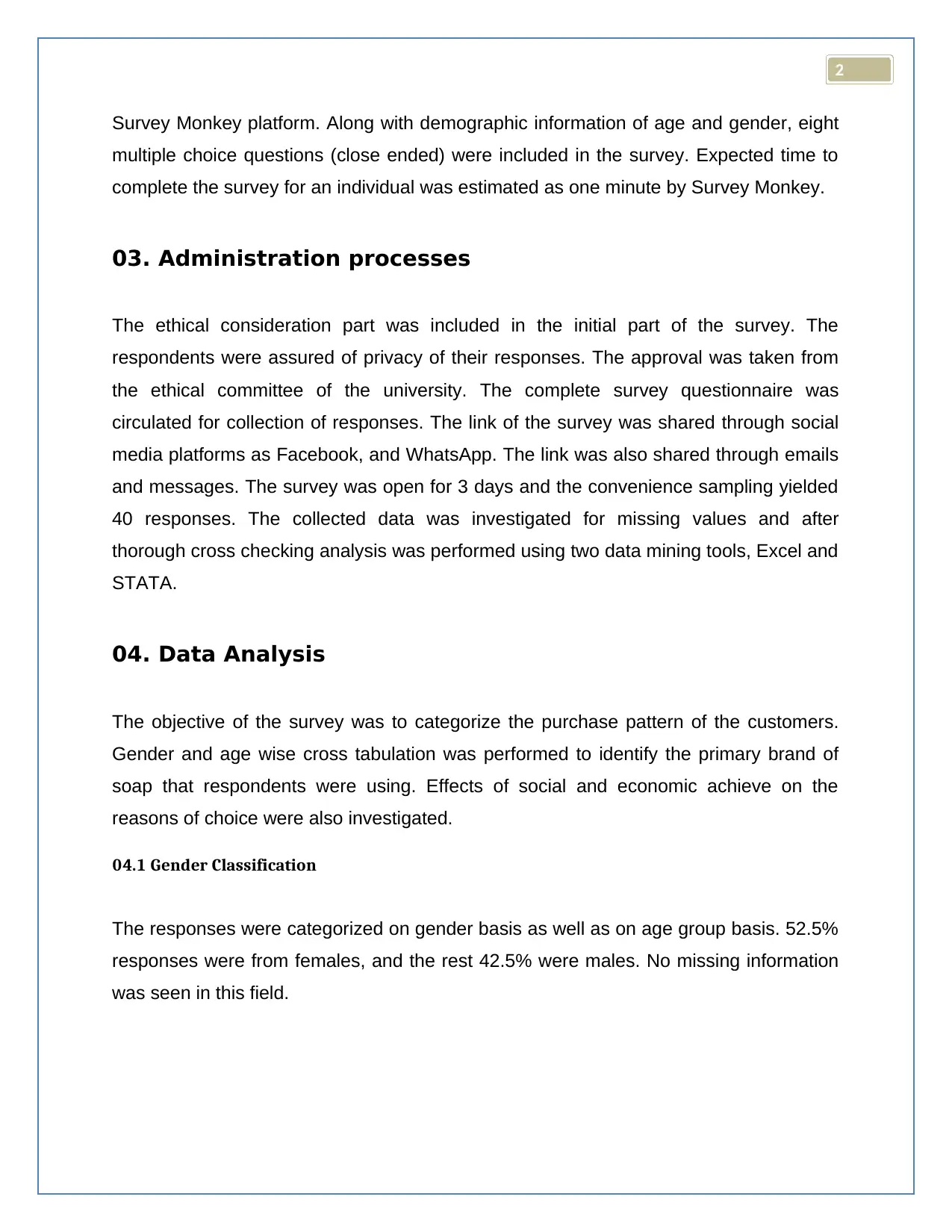
2
Survey Monkey platform. Along with demographic information of age and gender, eight
multiple choice questions (close ended) were included in the survey. Expected time to
complete the survey for an individual was estimated as one minute by Survey Monkey.
03. Administration processes
The ethical consideration part was included in the initial part of the survey. The
respondents were assured of privacy of their responses. The approval was taken from
the ethical committee of the university. The complete survey questionnaire was
circulated for collection of responses. The link of the survey was shared through social
media platforms as Facebook, and WhatsApp. The link was also shared through emails
and messages. The survey was open for 3 days and the convenience sampling yielded
40 responses. The collected data was investigated for missing values and after
thorough cross checking analysis was performed using two data mining tools, Excel and
STATA.
04. Data Analysis
The objective of the survey was to categorize the purchase pattern of the customers.
Gender and age wise cross tabulation was performed to identify the primary brand of
soap that respondents were using. Effects of social and economic achieve on the
reasons of choice were also investigated.
04.1 Gender Classification
The responses were categorized on gender basis as well as on age group basis. 52.5%
responses were from females, and the rest 42.5% were males. No missing information
was seen in this field.
Survey Monkey platform. Along with demographic information of age and gender, eight
multiple choice questions (close ended) were included in the survey. Expected time to
complete the survey for an individual was estimated as one minute by Survey Monkey.
03. Administration processes
The ethical consideration part was included in the initial part of the survey. The
respondents were assured of privacy of their responses. The approval was taken from
the ethical committee of the university. The complete survey questionnaire was
circulated for collection of responses. The link of the survey was shared through social
media platforms as Facebook, and WhatsApp. The link was also shared through emails
and messages. The survey was open for 3 days and the convenience sampling yielded
40 responses. The collected data was investigated for missing values and after
thorough cross checking analysis was performed using two data mining tools, Excel and
STATA.
04. Data Analysis
The objective of the survey was to categorize the purchase pattern of the customers.
Gender and age wise cross tabulation was performed to identify the primary brand of
soap that respondents were using. Effects of social and economic achieve on the
reasons of choice were also investigated.
04.1 Gender Classification
The responses were categorized on gender basis as well as on age group basis. 52.5%
responses were from females, and the rest 42.5% were males. No missing information
was seen in this field.
Paraphrase This Document
Need a fresh take? Get an instant paraphrase of this document with our AI Paraphraser
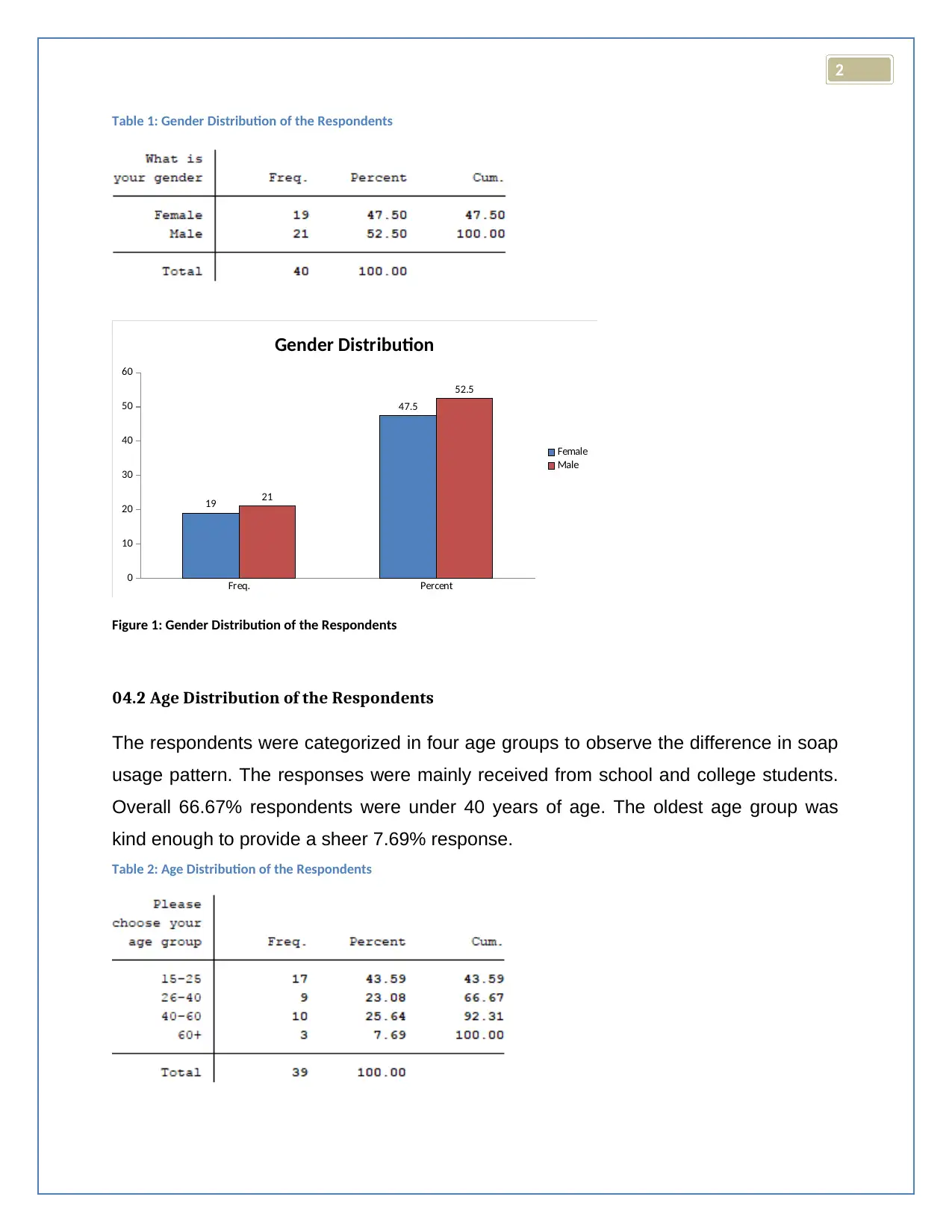
2
Table 1: Gender Distribution of the Respondents
Freq. Percent
0
10
20
30
40
50
60
19
47.5
21
52.5
Gender Distribution
Female
Male
Figure 1: Gender Distribution of the Respondents
04.2 Age Distribution of the Respondents
The respondents were categorized in four age groups to observe the difference in soap
usage pattern. The responses were mainly received from school and college students.
Overall 66.67% respondents were under 40 years of age. The oldest age group was
kind enough to provide a sheer 7.69% response.
Table 2: Age Distribution of the Respondents
Table 1: Gender Distribution of the Respondents
Freq. Percent
0
10
20
30
40
50
60
19
47.5
21
52.5
Gender Distribution
Female
Male
Figure 1: Gender Distribution of the Respondents
04.2 Age Distribution of the Respondents
The respondents were categorized in four age groups to observe the difference in soap
usage pattern. The responses were mainly received from school and college students.
Overall 66.67% respondents were under 40 years of age. The oldest age group was
kind enough to provide a sheer 7.69% response.
Table 2: Age Distribution of the Respondents
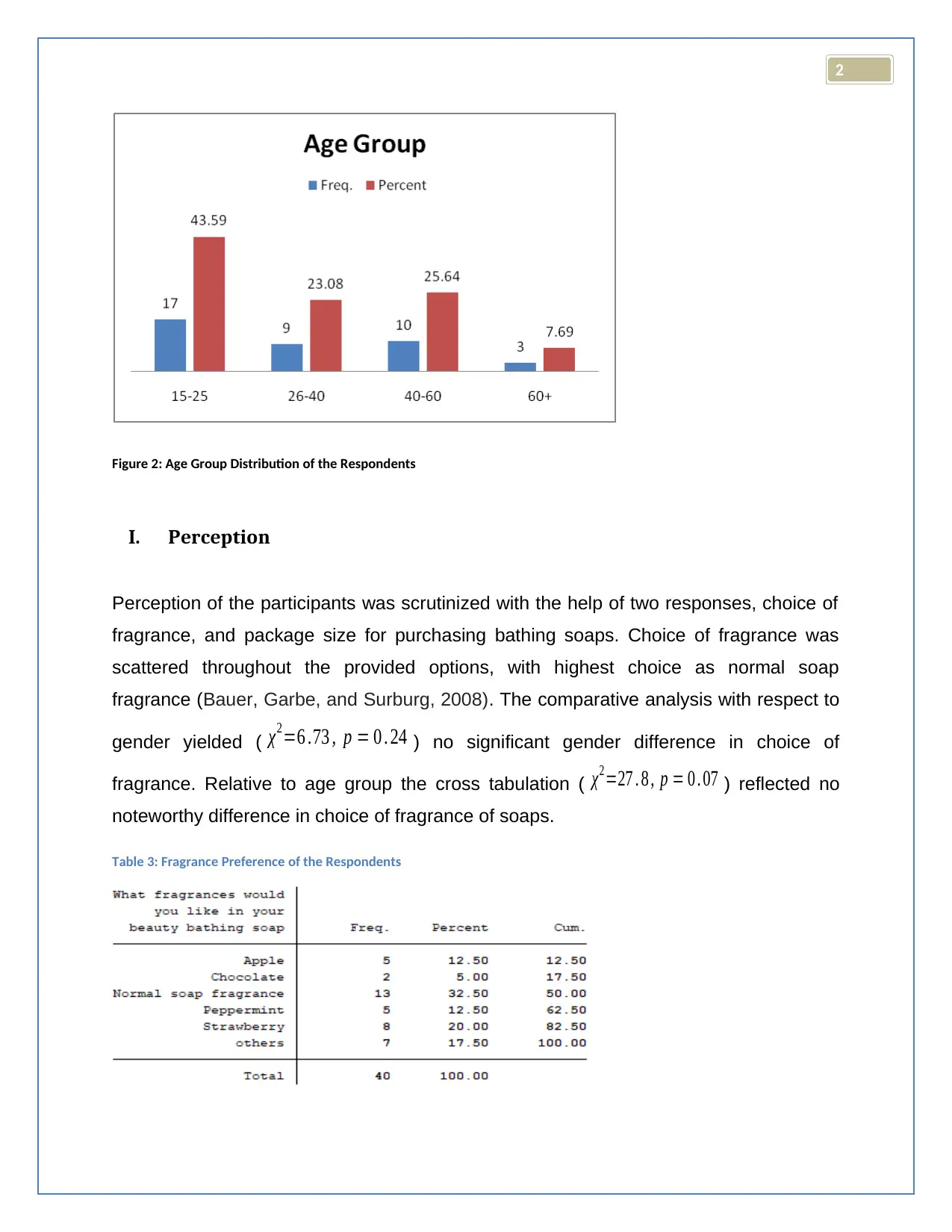
2
Figure 2: Age Group Distribution of the Respondents
I. Perception
Perception of the participants was scrutinized with the help of two responses, choice of
fragrance, and package size for purchasing bathing soaps. Choice of fragrance was
scattered throughout the provided options, with highest choice as normal soap
fragrance (Bauer, Garbe, and Surburg, 2008). The comparative analysis with respect to
gender yielded ( χ2=6 .73 , p = 0 . 24 ) no significant gender difference in choice of
fragrance. Relative to age group the cross tabulation ( χ2=27 . 8 , p = 0 . 07 ) reflected no
noteworthy difference in choice of fragrance of soaps.
Table 3: Fragrance Preference of the Respondents
Figure 2: Age Group Distribution of the Respondents
I. Perception
Perception of the participants was scrutinized with the help of two responses, choice of
fragrance, and package size for purchasing bathing soaps. Choice of fragrance was
scattered throughout the provided options, with highest choice as normal soap
fragrance (Bauer, Garbe, and Surburg, 2008). The comparative analysis with respect to
gender yielded ( χ2=6 .73 , p = 0 . 24 ) no significant gender difference in choice of
fragrance. Relative to age group the cross tabulation ( χ2=27 . 8 , p = 0 . 07 ) reflected no
noteworthy difference in choice of fragrance of soaps.
Table 3: Fragrance Preference of the Respondents
⊘ This is a preview!⊘
Do you want full access?
Subscribe today to unlock all pages.

Trusted by 1+ million students worldwide
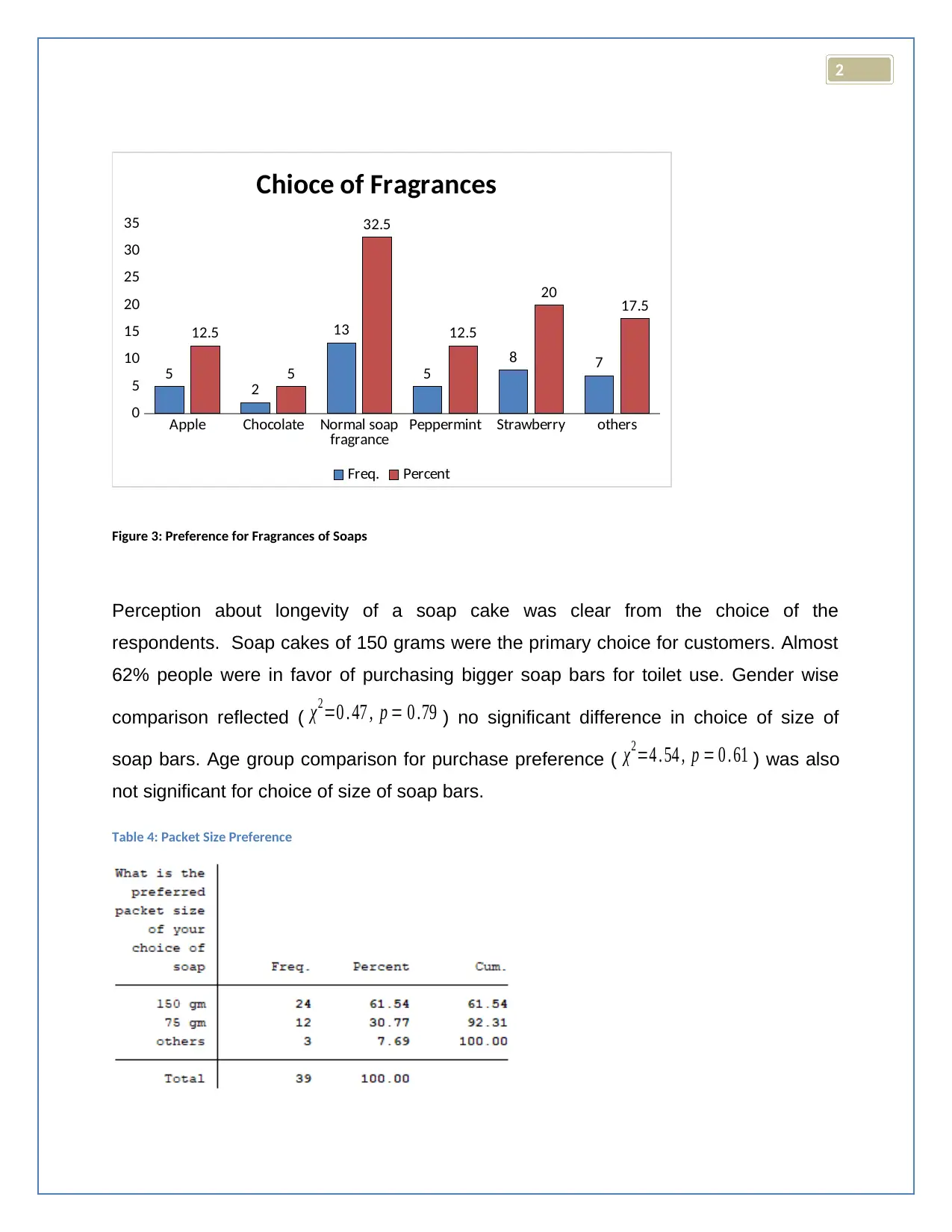
2
Apple Chocolate Normal soap
fragrance Peppermint Strawberry others
0
5
10
15
20
25
30
35
5
2
13
5
8 7
12.5
5
32.5
12.5
20 17.5
Chioce of Fragrances
Freq. Percent
Figure 3: Preference for Fragrances of Soaps
Perception about longevity of a soap cake was clear from the choice of the
respondents. Soap cakes of 150 grams were the primary choice for customers. Almost
62% people were in favor of purchasing bigger soap bars for toilet use. Gender wise
comparison reflected ( χ2=0 . 47 , p = 0 .79 ) no significant difference in choice of size of
soap bars. Age group comparison for purchase preference ( χ2=4 . 54 , p = 0 . 61 ) was also
not significant for choice of size of soap bars.
Table 4: Packet Size Preference
Apple Chocolate Normal soap
fragrance Peppermint Strawberry others
0
5
10
15
20
25
30
35
5
2
13
5
8 7
12.5
5
32.5
12.5
20 17.5
Chioce of Fragrances
Freq. Percent
Figure 3: Preference for Fragrances of Soaps
Perception about longevity of a soap cake was clear from the choice of the
respondents. Soap cakes of 150 grams were the primary choice for customers. Almost
62% people were in favor of purchasing bigger soap bars for toilet use. Gender wise
comparison reflected ( χ2=0 . 47 , p = 0 .79 ) no significant difference in choice of size of
soap bars. Age group comparison for purchase preference ( χ2=4 . 54 , p = 0 . 61 ) was also
not significant for choice of size of soap bars.
Table 4: Packet Size Preference
Paraphrase This Document
Need a fresh take? Get an instant paraphrase of this document with our AI Paraphraser
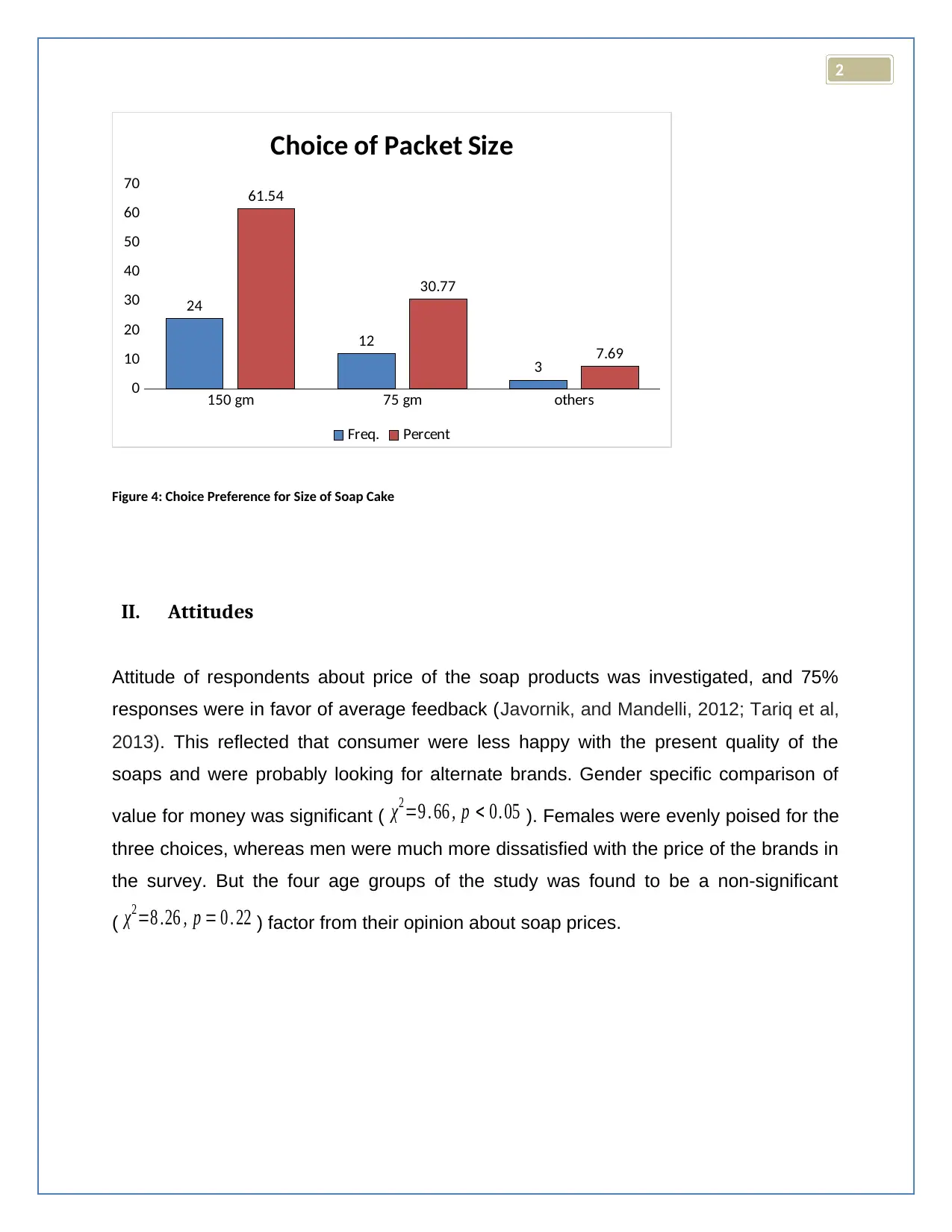
2
150 gm 75 gm others
0
10
20
30
40
50
60
70
24
12
3
61.54
30.77
7.69
Choice of Packet Size
Freq. Percent
Figure 4: Choice Preference for Size of Soap Cake
II. Attitudes
Attitude of respondents about price of the soap products was investigated, and 75%
responses were in favor of average feedback (Javornik, and Mandelli, 2012; Tariq et al,
2013). This reflected that consumer were less happy with the present quality of the
soaps and were probably looking for alternate brands. Gender specific comparison of
value for money was significant ( χ2=9 . 66 , p < 0. 05 ). Females were evenly poised for the
three choices, whereas men were much more dissatisfied with the price of the brands in
the survey. But the four age groups of the study was found to be a non-significant
( χ2=8 .26 , p = 0 . 22 ) factor from their opinion about soap prices.
150 gm 75 gm others
0
10
20
30
40
50
60
70
24
12
3
61.54
30.77
7.69
Choice of Packet Size
Freq. Percent
Figure 4: Choice Preference for Size of Soap Cake
II. Attitudes
Attitude of respondents about price of the soap products was investigated, and 75%
responses were in favor of average feedback (Javornik, and Mandelli, 2012; Tariq et al,
2013). This reflected that consumer were less happy with the present quality of the
soaps and were probably looking for alternate brands. Gender specific comparison of
value for money was significant ( χ2=9 . 66 , p < 0. 05 ). Females were evenly poised for the
three choices, whereas men were much more dissatisfied with the price of the brands in
the survey. But the four age groups of the study was found to be a non-significant
( χ2=8 .26 , p = 0 . 22 ) factor from their opinion about soap prices.
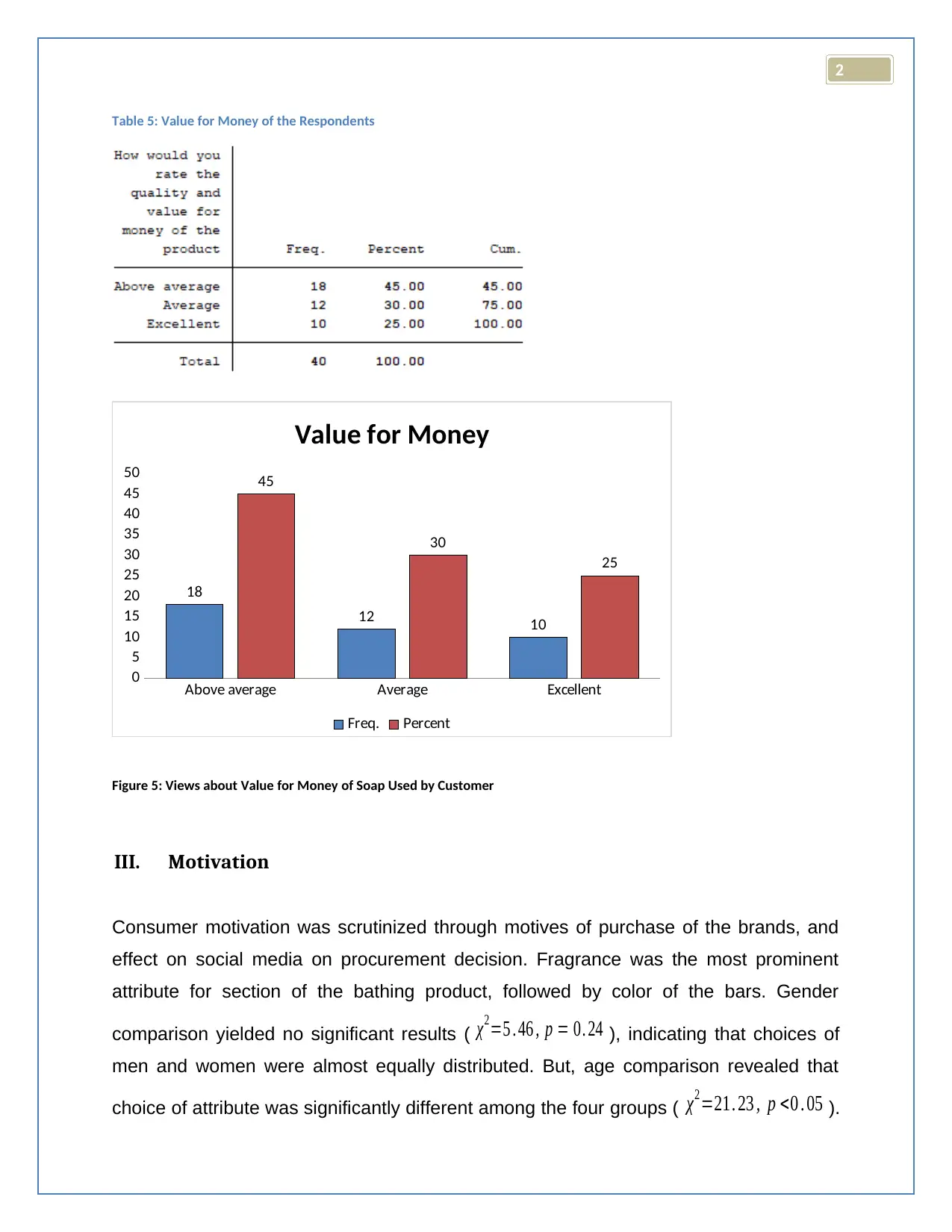
2
Table 5: Value for Money of the Respondents
Above average Average Excellent
0
5
10
15
20
25
30
35
40
45
50
18
12 10
45
30
25
Value for Money
Freq. Percent
Figure 5: Views about Value for Money of Soap Used by Customer
III. Motivation
Consumer motivation was scrutinized through motives of purchase of the brands, and
effect on social media on procurement decision. Fragrance was the most prominent
attribute for section of the bathing product, followed by color of the bars. Gender
comparison yielded no significant results ( χ2=5 . 46 , p = 0. 24 ), indicating that choices of
men and women were almost equally distributed. But, age comparison revealed that
choice of attribute was significantly different among the four groups ( χ2=21. 23 , p <0 . 05 ).
Table 5: Value for Money of the Respondents
Above average Average Excellent
0
5
10
15
20
25
30
35
40
45
50
18
12 10
45
30
25
Value for Money
Freq. Percent
Figure 5: Views about Value for Money of Soap Used by Customer
III. Motivation
Consumer motivation was scrutinized through motives of purchase of the brands, and
effect on social media on procurement decision. Fragrance was the most prominent
attribute for section of the bathing product, followed by color of the bars. Gender
comparison yielded no significant results ( χ2=5 . 46 , p = 0. 24 ), indicating that choices of
men and women were almost equally distributed. But, age comparison revealed that
choice of attribute was significantly different among the four groups ( χ2=21. 23 , p <0 . 05 ).
⊘ This is a preview!⊘
Do you want full access?
Subscribe today to unlock all pages.

Trusted by 1+ million students worldwide
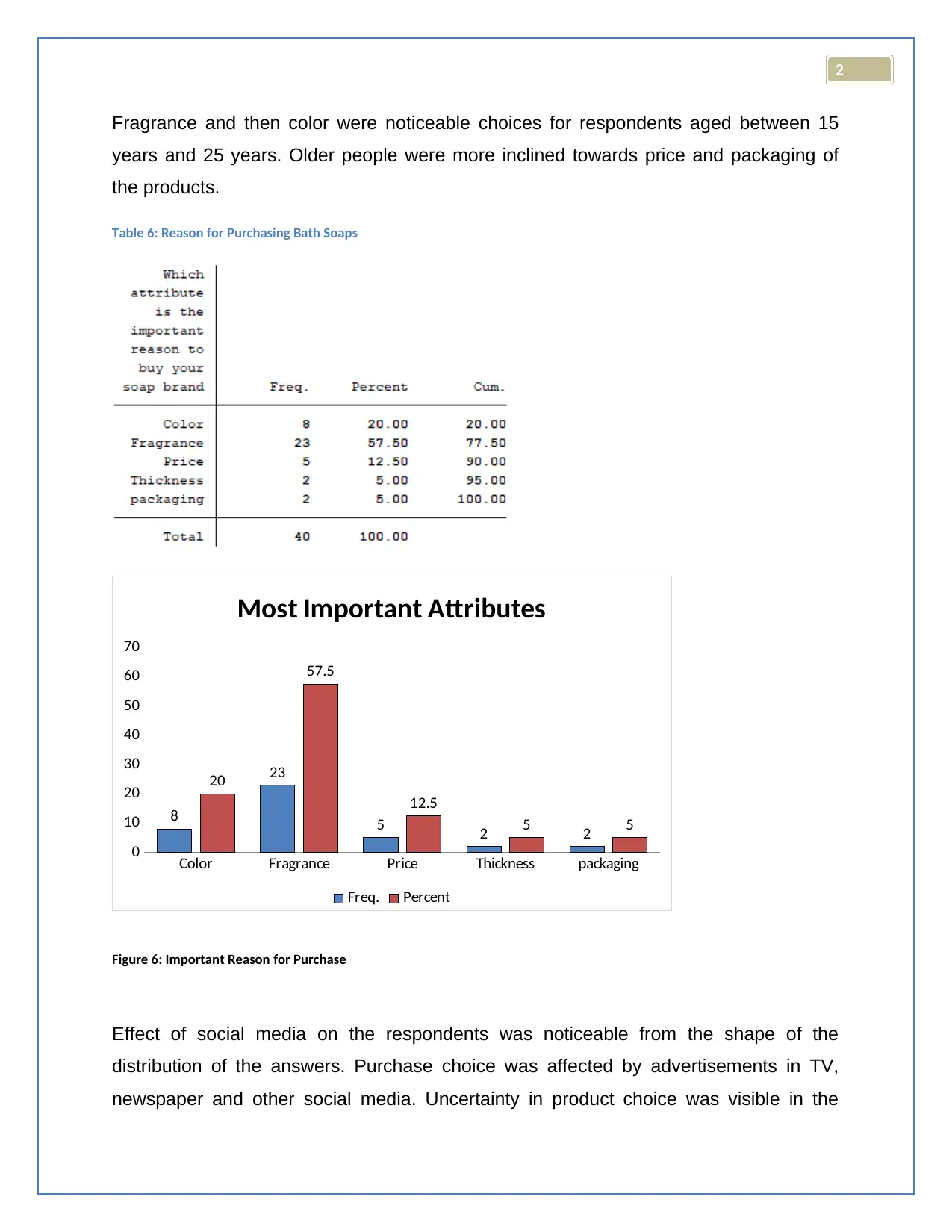
2
Fragrance and then color were noticeable choices for respondents aged between 15
years and 25 years. Older people were more inclined towards price and packaging of
the products.
Table 6: Reason for Purchasing Bath Soaps
Color Fragrance Price Thickness packaging
0
10
20
30
40
50
60
70
8
23
5 2 2
20
57.5
12.5
5 5
Most Important Attributes
Freq. Percent
Figure 6: Important Reason for Purchase
Effect of social media on the respondents was noticeable from the shape of the
distribution of the answers. Purchase choice was affected by advertisements in TV,
newspaper and other social media. Uncertainty in product choice was visible in the
Fragrance and then color were noticeable choices for respondents aged between 15
years and 25 years. Older people were more inclined towards price and packaging of
the products.
Table 6: Reason for Purchasing Bath Soaps
Color Fragrance Price Thickness packaging
0
10
20
30
40
50
60
70
8
23
5 2 2
20
57.5
12.5
5 5
Most Important Attributes
Freq. Percent
Figure 6: Important Reason for Purchase
Effect of social media on the respondents was noticeable from the shape of the
distribution of the answers. Purchase choice was affected by advertisements in TV,
newspaper and other social media. Uncertainty in product choice was visible in the
Paraphrase This Document
Need a fresh take? Get an instant paraphrase of this document with our AI Paraphraser
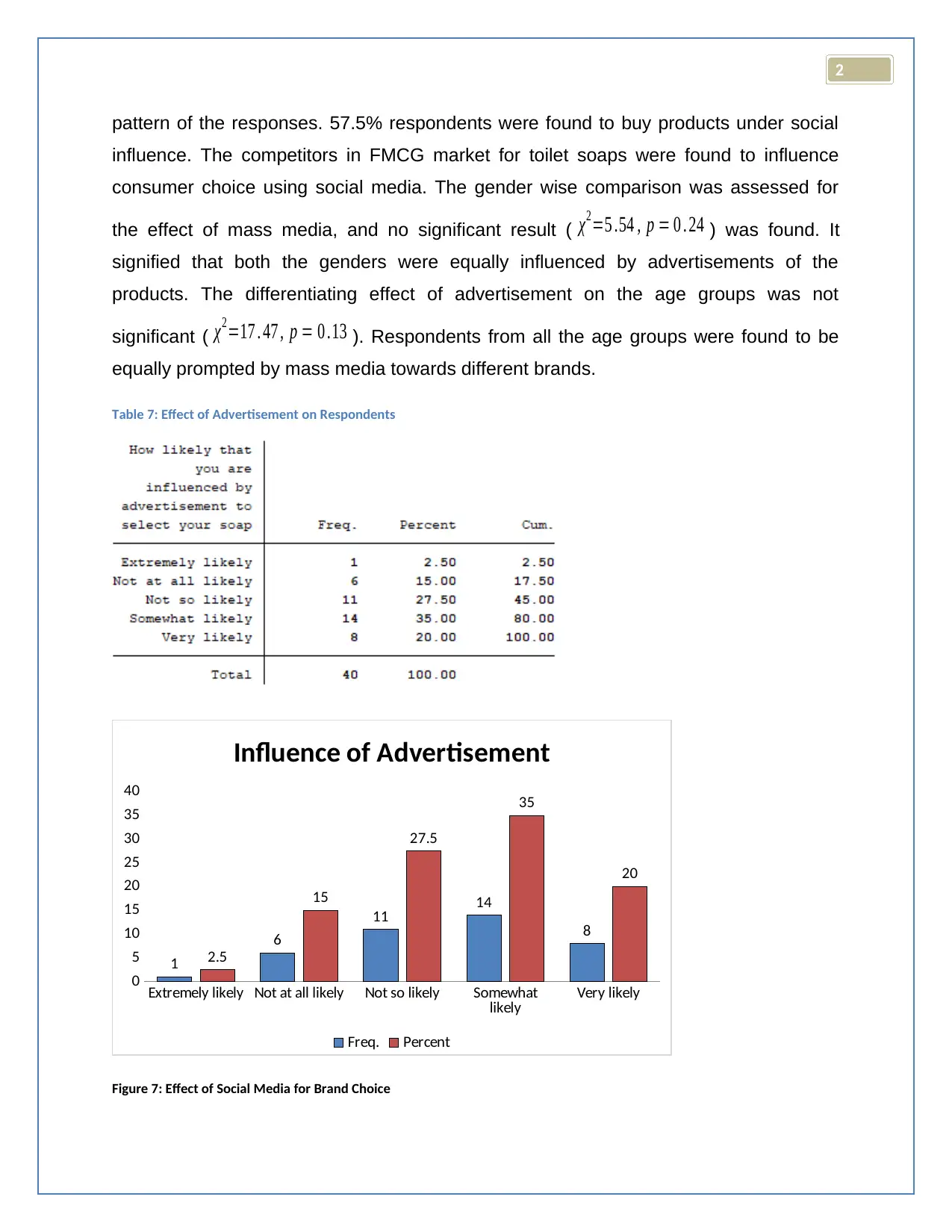
2
pattern of the responses. 57.5% respondents were found to buy products under social
influence. The competitors in FMCG market for toilet soaps were found to influence
consumer choice using social media. The gender wise comparison was assessed for
the effect of mass media, and no significant result ( χ2=5 .54 , p = 0 . 24 ) was found. It
signified that both the genders were equally influenced by advertisements of the
products. The differentiating effect of advertisement on the age groups was not
significant ( χ2=17 . 47 , p = 0 .13 ). Respondents from all the age groups were found to be
equally prompted by mass media towards different brands.
Table 7: Effect of Advertisement on Respondents
Extremely likely Not at all likely Not so likely Somewhat
likely Very likely
0
5
10
15
20
25
30
35
40
1
6
11 14
8
2.5
15
27.5
35
20
Influence of Advertisement
Freq. Percent
Figure 7: Effect of Social Media for Brand Choice
pattern of the responses. 57.5% respondents were found to buy products under social
influence. The competitors in FMCG market for toilet soaps were found to influence
consumer choice using social media. The gender wise comparison was assessed for
the effect of mass media, and no significant result ( χ2=5 .54 , p = 0 . 24 ) was found. It
signified that both the genders were equally influenced by advertisements of the
products. The differentiating effect of advertisement on the age groups was not
significant ( χ2=17 . 47 , p = 0 .13 ). Respondents from all the age groups were found to be
equally prompted by mass media towards different brands.
Table 7: Effect of Advertisement on Respondents
Extremely likely Not at all likely Not so likely Somewhat
likely Very likely
0
5
10
15
20
25
30
35
40
1
6
11 14
8
2.5
15
27.5
35
20
Influence of Advertisement
Freq. Percent
Figure 7: Effect of Social Media for Brand Choice
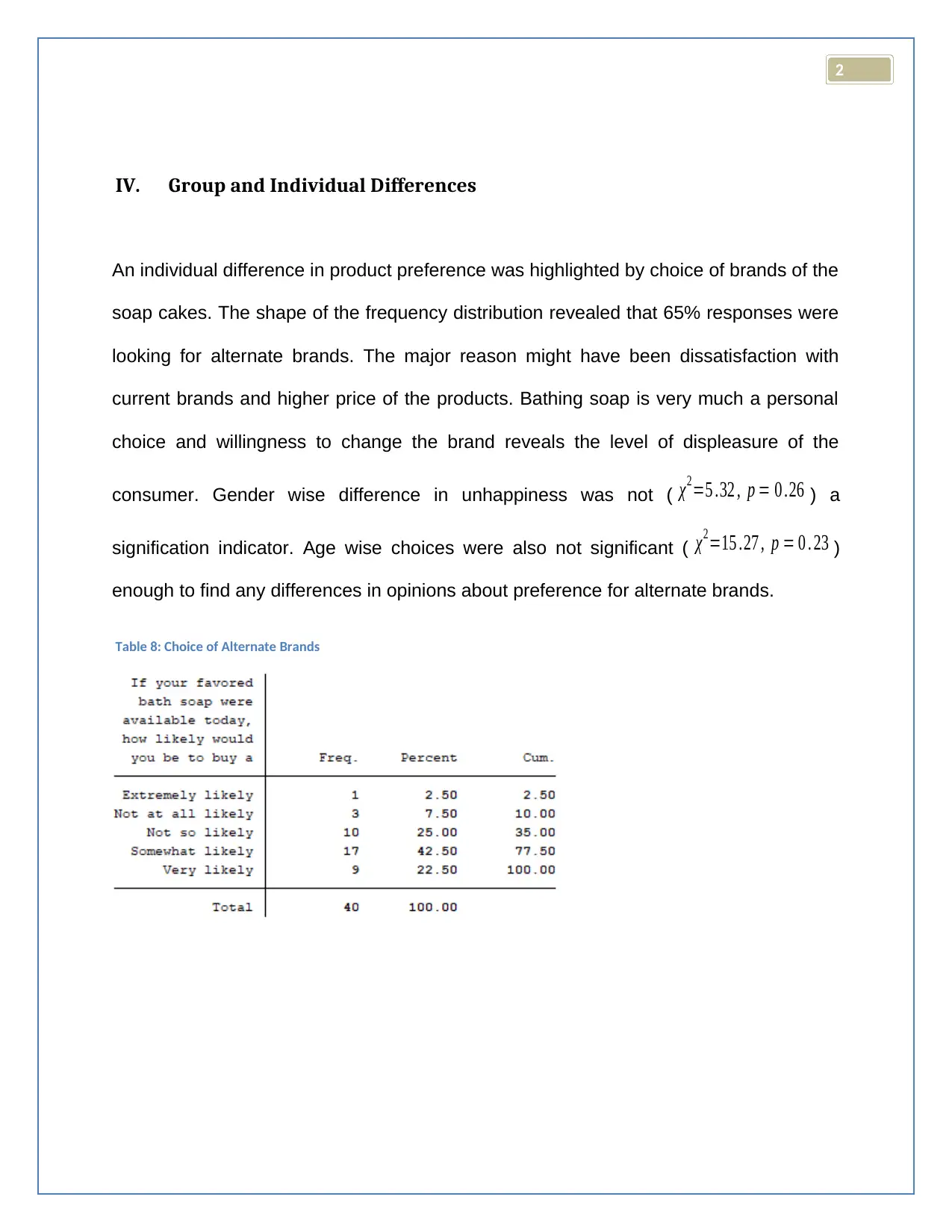
2
IV. Group and Individual Differences
An individual difference in product preference was highlighted by choice of brands of the
soap cakes. The shape of the frequency distribution revealed that 65% responses were
looking for alternate brands. The major reason might have been dissatisfaction with
current brands and higher price of the products. Bathing soap is very much a personal
choice and willingness to change the brand reveals the level of displeasure of the
consumer. Gender wise difference in unhappiness was not ( χ2=5 .32 , p = 0 .26 ) a
signification indicator. Age wise choices were also not significant ( χ2=15 .27 , p = 0 . 23 )
enough to find any differences in opinions about preference for alternate brands.
Table 8: Choice of Alternate Brands
IV. Group and Individual Differences
An individual difference in product preference was highlighted by choice of brands of the
soap cakes. The shape of the frequency distribution revealed that 65% responses were
looking for alternate brands. The major reason might have been dissatisfaction with
current brands and higher price of the products. Bathing soap is very much a personal
choice and willingness to change the brand reveals the level of displeasure of the
consumer. Gender wise difference in unhappiness was not ( χ2=5 .32 , p = 0 .26 ) a
signification indicator. Age wise choices were also not significant ( χ2=15 .27 , p = 0 . 23 )
enough to find any differences in opinions about preference for alternate brands.
Table 8: Choice of Alternate Brands
⊘ This is a preview!⊘
Do you want full access?
Subscribe today to unlock all pages.

Trusted by 1+ million students worldwide
1 out of 38
Related Documents
Your All-in-One AI-Powered Toolkit for Academic Success.
+13062052269
info@desklib.com
Available 24*7 on WhatsApp / Email
![[object Object]](/_next/static/media/star-bottom.7253800d.svg)
Unlock your academic potential
Copyright © 2020–2025 A2Z Services. All Rights Reserved. Developed and managed by ZUCOL.





